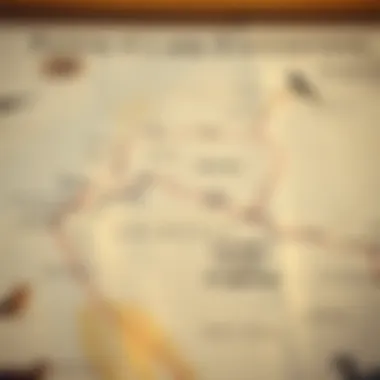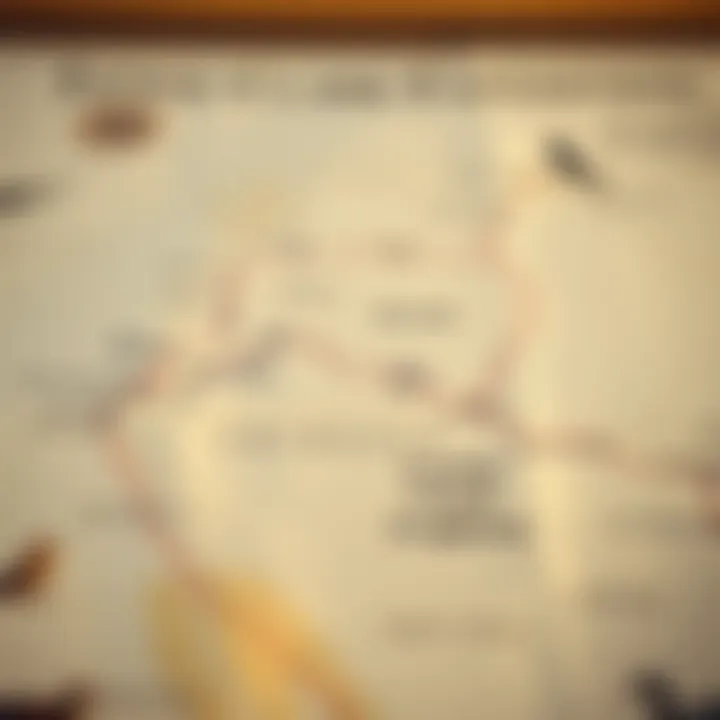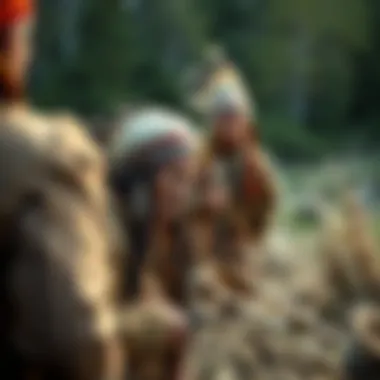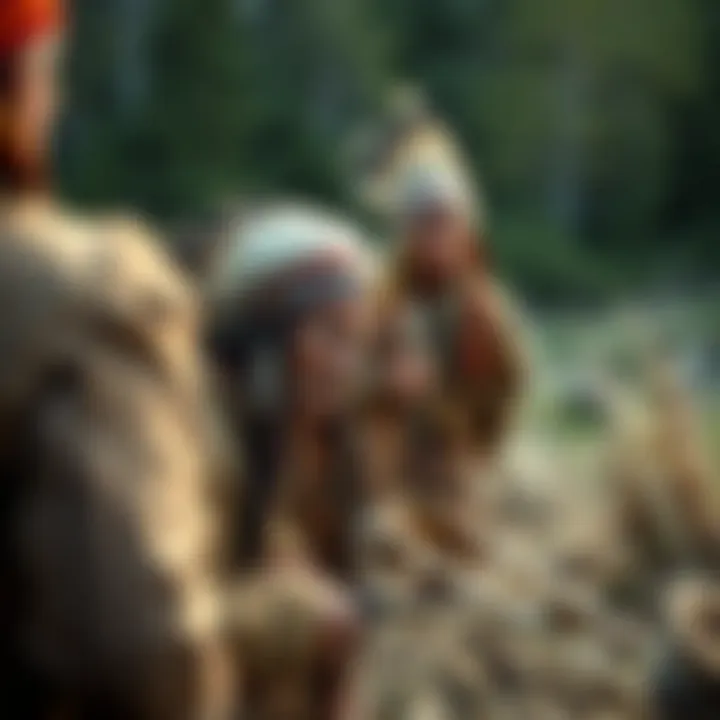Exploring the Lewis and Clark Journals: A Journey Through Discovery


Nature Topic Overview
The Lewis and Clark expedition, which unfolded from 1804 to 1806, stands as a monumental chapter in American history. Embarking from St. Louis, Meriwether Lewis and William Clark took their journey through the uncharted territories of the American West. Their detailed journals are not just mere records of a trip; they're windows into the past. These writings capture the essence of a nation in the making and offer insights into the diverse landscapes, wildlife, and the vibrant cultures they encountered along the way.
What makes the journals particularly fascinating is their meticulous observation of the terrain and its inhabitants. Lewis and Clark didn't just chart paths; they painted vivid pictures of their experiences, from the towering Rocky Mountains to the flowing rivers that teemed with fish and various wildlife.
Their encounters with Native American tribes, each with distinct languages, customs, and practices, highlight a rich tapestry of cultural exchange. Understanding these interactions is vital as they provide context to the broader implications of exploration and colonization in the United States.
This exploration serves as an exciting bridge between nature and history, emphasizing that learning about our past can deeply enrich our appreciation for the present and future.
Fun Facts and Trivia
Did you know? The journey covered over 8,000 miles! Here are some captivating facts that will spark interest in young explorers:
- Sacagawea: The renowned Native American woman who guided Lewis and Clark played a crucial role in their expedition. Her knowledge of the land helped them navigate unfamiliar territories.
- Animal Sightings: They were the first Americans to describe numerous species, like the grizzly bear and the prairie dog, in their journals.
- Weather Observations: The team diligently noted down not just the landscape but also weather conditions. They reported everything from scorching heat to fierce snowstorms, showcasing the unpredictable nature of the American wilderness.
To make this even more engaging, there can be visuals like maps, drawings from the journals, or even short quizzes that involve spotting different animals they encountered.
Wildlife Explorations
As Lewis and Clark journeyed through valleys and mountains, they documented various plants and animals. The clash of diverse ecosystems made their expedition an incredibly rich study of biodiversity.
- Bison: Massive and majestic, bison roamed the plains in enormous herds. Their size and strength were awe-inspiring and formed an important part of Native American culture.
- Peregrine Falcon: This incredible bird is known for its speed. The journals mention sightings of this agile predator as they soared through the vast skies.
- Various Flora: From towering pines to vibrant wildflowers, the expedition team encountered unique plant species that decorated the landscapes.
To engage young minds further, creating puzzles or a matching game between animal pictures and their descriptions could enrich their learning experience.
Environmental Awareness
The Lewis and Clark journey teaches us about the natural world, prompting reflection on our relationship with the environment. Understanding how they navigated and preserved the beauty of nature instills a sense of responsibility in young readers. Conservation of resources like clean water, forests, and wildlife is paramount.
- Importance of Conservation: Just as the explorers documented the land, today's young adventurers can learn how to protect our environment, ensuring future generations enjoy similar experiences.
- Tips for Kids: Simple steps can make a difference! Picking up litter when visiting parks or planting a small garden can contribute to the planet’s health.
DIY Nature Activities
To deepen the connection with nature and history, trying out some simple DIY activities can be enjoyable. Here’s a straightforward craft you can start with:
- Nature Journal: Encourage kids to create their own journals similar to Lewis and Clark's. They can draw pictures of plants or animals they see or write short stories about their discoveries on family hikes.
- Leaf Rubbings: Collect leaves from different trees and cover them with paper. Using a crayon, rub over the top to capture their shapes and textures!
- Outdoor Explorations: Plan a day out in local parks where kids can observe different wildlife. They can use binoculars to look at birds or start a mini-scouting mission to note down everything they discover.
Engaging in these activities helps foster a love for adventure and the earth, much like Lewis and Clark did in their travels.
Overview of the Lewis and Clark Expedition
The Lewis and Clark Expedition holds a remarkable place in American history, serving as both a thrilling exploration and a critical moment of cultural exchange. This monumental journey, which took place between 1804 and 1806, marked the first time that Americans traversed the vast lands acquired in the Louisiana Purchase. Understanding this expedition reveals much about the nation’s early ambitions, the natural landscapes that were unfolding before them, and the rich tapestry of cultures they encountered along the way.
Key points that will be discussed in this section include:
- The historical context of the expedition, setting the stage for the adventure that awaited.
- Clarification of the aims and objectives that drove Lewis and Clark into the uncharted territories.
- Insight into the enduring impact this journey has had on America’s development.
By guiding readers through these facets, we paint a vivid picture not just of exploration but of the deeper implications tied to environmental awareness and inter-cultural interactions. The thrilling spirit of discovery resonates through the journals of Lewis and Clark, as they documented everything from river crossings to encounters with diverse Native tribes, offering a window into both their experiences and the landscapes they explored.
Background of the Expedition
Although the core team was led by Meriwether Lewis and William Clark, the roots of their expedition grow from a complex backdrop of political and social change. President Thomas Jefferson, keen on expanding the young nation’s knowledge and territory, viewed the Louisiana Purchase as a golden opportunity. By commissioning this exploratory mission, Jefferson aimed to map uncharted territories, seek a passage to the Pacific Ocean, and establish diplomatic relations with Native tribes.
In keeping with this vision, Lewis and Clark prepared not just for an adventure but for serious scientific inquiry. The motivations were driven by a quest for knowledge, pushing the boundaries of what was known while striving to solidify ownership and stewardship of the land for the United States. Their journals became crucial records, chronicling detailed observations about the geography, people, and flora and fauna encountered.
Objectives and Goals
The expedition was founded on a series of clear objectives that highlight its significance. These included:
- Mapping the Louisiana Territory: The expedition sought to produce accurate maps of previously unexplored regions, which were vital for future expansion efforts.
- Surveying the Land’s Resources: Lewis and Clark aimed to record the natural resources of the land, including plants that could be utilized and animals that could be hunted.
- Establishing Trade Routes: Another critical goal was to identify and develop relationships with Native American tribes to facilitate trade and secure alliances.
- Scientific Exploration: The expedition aimed to gather scientific data that could contribute to the broader understanding of the North American ecosystem and its inhabitants.
Understanding these goals offers not just an appreciation for historical context but also a recognition of the ambition and vision behind the expedition. The journals filled with notes, drawings, and personal reflections provide remarkable insight into not just the landscape they traversed but the inclusivity of various cultures they encountered.
In summary, the Lewis and Clark Expedition is not merely a tale of exploring new lands; it is also a narrative intertwined with ambition, discovery, and the groundwork for future generations.
"The Lewis and Clark journey was one of the first great expeditions in the United States; it symbolizes the spirit of adventure and the quest for understanding our world."
For further reading on the historical significance of this expedition, you can check out Britannica or Wikipedia.
The Journals: A Primary Source


The journals of Lewis and Clark stand as a fascinating primary source, illuminating not just a journey across unknown territories but also a pivotal moment in American history. These diaries offer a firsthand account of the expedition, filled with observations that paint a vivid picture of the landscapes and cultures encountered. Readers can truly step into the shoes of explorers navigating through uncharted lands.
What Constitutes a Primary Source?
Understanding what a primary source is can be as simple as looking at items from a specific time period or event. A primary source originates from the original context, such as letters, official documents, or, in this case, journals.
The journals written by Lewis and Clark are unique for several reasons:
- Authenticity: The entries are unfiltered, detailing daily life, challenges faced, and discoveries made.
- Personal Perspective: Readers see the thoughts and emotions of the expedition members, providing context that a textbook might lack.
- Historical Significance: These writings offer insights into early American exploration, making them key to understanding deeper historical narratives.
In educational settings, primary sources like these journals inspire curiosity and critical thinking in young learners. They allow students to engage directly with history rather than just reading about it in secondary accounts.
Structure and Content of the Journals
The structure of the Lewis and Clark journals is quite straightforward, yet, it reveals a depth of detail that informs modern readers about their journey. Each entry typically includes dates and locations, alongside sketches and drawings. This is significant because:
- Chronological Order: Following the journey in the sequence it happened helps understand the explorers' challenges and triumphs in context.
- Descriptive Richness: Lewis and Clark recorded their observations about the natural world, including locations—such as riverbanks, mountains, and forests—and the animals and plants they encountered.
- Encounters with People: Their interactions with Native American tribes are described throughout the journals, showcasing cultural exchanges, trade, and sometimes conflict. This emphasizes not just what was encountered on the path but the people whose lands they were traversing.
To summarize, the journals serve as both a historical record and a narrative adventure. They encapsulate the spirit of exploration, highlighting human connection to nature and to one another, making it an invaluable resource for education.
"The journals are not mere accounts of travel but a testament to discovery and understanding of the world during a crucial time in American history."
These elements come together to provide readers, especially young ones, with an engaging way to explore the past while recognizing its relevance in today's world.
Key Themes in the Journals
The journals of Lewis and Clark are not just records of a journey; they are rich tapestries of the environment, people, and challenges faced during their expedition. Each theme explored in the journals sheds light on a different aspect of their experience and contributes to a broader understanding of America's early exploration.
Nature and the Environment
Descriptions of Flora
The descriptions of flora in the Lewis and Clark journals highlight the incredible diversity of plant life they encountered. From towering trees to delicate wildflowers, these observations help us appreciate the unique ecosystems they navigated. The key characteristic here is the meticulous detail with which the explorers documented everything from the height of a tree to the color of a blossom. This is a valuable choice for the audience, as it sparks curiosity about the natural world.
A unique feature of these descriptions is how they capture both familiar and unknown species. For instance, Lewis noted familiar food sources, such as berries, while also marveling at exotic plants previously unseen. This brings an advantage in education, allowing young readers to connect their world with history.
Wildlife Encounters
Wildlife encounters are another significant aspect documented within the journals. The explorers recorded the sights and sounds of many animals, showcasing a variety of species from graceful deer to curious bears. These encounters highlight the richness of North America's wildlife, making it a popular subject for the article.
The unique feature here is the blending of scientific observation with personal reflection. Lewis and Clark didn't just list animals; they described their behavior, habitat, and interactions. This creates an engaging narrative that enhances understanding of nature, despite the dangers presented by some wildlife.
Geological Observations
The geological observations by Lewis and Clark convey the dramatic landscapes they traversed. From mountains looming high into the sky to rivers carving their way through valleys, these notes paint a vivid picture. This aspect is critical because it reveals the natural forces shaping the land.
The journals include descriptions of rock formations and mineral deposits, which present unique insights into the earth's history. Though technical, these observations can draw in curiosity and intrigue among readers, exhibiting how geology played a prominent role in their journey and further exploration of the continent.
Interactions with Indigenous Peoples
Cultural Exchanges
Cultural exchanges documented in the journals delve into the interactions between Lewis and Clark and various Native American tribes. These encounters were not mere transactions; they became intricate webs of understanding and misunderstanding. The key characteristic of these exchanges showcases the explorers' eagerness to learn, which is beneficial for education about diplomacy and communication with diverse cultures.
A unique feature is how these exchanges depicted both cooperation and conflict. The descriptions convey the shared traditions and knowledge, alongside the struggles faced by the explorers. This honest depiction allows for a deeper understanding of history from multiple perspectives, enriching the educational experience.
Trade and Diplomacy
Lewis and Clark encountered numerous tribal leaders and engaged in trade practices that were central to their survival. This aspect of trade and diplomacy illustrates the reciprocal relationships formed during their expedition. The journals emphasize the significance of diplomacy, revealing how mutual respect often led to successful negotiations.
A unique feature of this theme is the way it highlights tangible items exchanged, such as beads and tools. These object exchanges represent not just material transactions but are also symbolic of cultural connections, teaching young learners about the importance of trade and communication in history.
Challenges and Conflicts
While the expedition aimed to forge peaceful relationships, the journals also recount numerous challenges and conflicts that arose. These instances provide a complex view of their journey, showcasing that exploration is often fraught with tension. Here lies the key characteristic of realism in the narratives, making it a significant addition to this work.
Unique here is the navigation of misunderstandings that led to both friendly and hostile encounters. This portrayal gives young readers a nuanced understanding of the historical context and the pivotal role of conflict resolution in both exploration and frontier living.
Adventures and Hardships
Navigation Challenges


The navigation challenges faced by Lewis and Clark form another compelling theme within their journals. Reflecting on their trials with rivers, lakes, and mountainous terrains, the explorers provide insight into the difficulties of charting unknown territories.
A notable feature is the detailed maps and sketches they created, showing how they worked tirelessly to traverse complex landscapes. For the target audience, understanding these challenges showcases the explorers’ resilience and creativity in problem-solving.
Health and Wellbeing
Health and wellbeing were constantly at risk during the expedition, evidenced by the explorers’ accounts of illness and injuries. This theme is crucial as it addresses the physical and mental strains caused by such an arduous journey.
The key characteristic highlighted is the fluctuating health of the crew, revealing how challenges altered not just their journey’s trajectory, but also their camaraderie. This provides a relatable and humanizing touch to the narrative, offering educators a chance to discuss emotional well-being with young students.
Weather and Terrain Obstacles
Weather and terrain obstacles serve as another formidable challenge documented in the journals. From torrential rains to perilous snowstorms, these elements often dictated the explorers' pace and progress. The climatic extremes they faced are a prominent highlight in the journals, illustrating nature's undeniable power.
A unique feature here is the vivid descriptions of these weather events, giving life to harsh conditions. By understanding these hardships, young readers can appreciate the journey's epic nature and the explorers' spirit. The combination of weather and terrain illustrates nature's challenges, fostering respect and understanding of the environment.
Scientific Contributions of the Expedition
The expedition led by Meriwether Lewis and William Clark was not just about crossing uncharted territories; it was a remarkable journey of scientific exploration and discovery. The journals penned by Lewis and Clark are treasure troves of information that significantly contributed to the understanding of North America's biodiversity. In these writings, one can find meticulous observations that span a vast array of natural phenomena, including botanical and zoological discoveries. These contributions hold profound importance in today’s context, as they set the stage for future researchers and explorers to delve deeper into America’s wild landscapes.
Through their documentation, we learned how climate, geography, and ecology interacted in ways that were novel for that time. Their insights not only documented existing knowledge but also paved the path for advancements in science, ecology, and conservation. The importance of these contributions is underscored by how they have been used by scientists and educators to inspire future generations.
"The Lewis and Clark journals serve as a linchpin in the history of American science, combining adventure with meticulous study of the natural world." - Historian
Botanical Discoveries
Lewis and Clark’s expedition recorded a surprising number of botanical discoveries that were previously unknown to European Americans. As they traversed different terrains—from the thick forests to open plains, they not only documented the plants they encountered but also categorized them based on their usefulness and ecological significance. Some key findings include:
- New Species: The few plants identified during the expedition, such as the Lewisia rediviva, a flowering plant named after Lewis himself, showcased the rich variety the continent held.
- Medicinal Uses: They noted the various medicinal properties of plants, which was essential allying to Indigenous practices of herbal medicine.
- Ecosystem Interactions: Their writings touched upon how different plants coexisted and supported local wildlife. This provided a glimpse into the complex web of ecosystem relationships, a theme that continues to resonate in ecological studies today.
As youngsters discover these botanical wonders, they can better appreciate how plants thrive in their own environments and why they matter to our ecosystem.
Zoological Findings
In addition to documenting plant life, the expedition made critical zoological findings that opened eyes to the wildlife that roamed the land. The journals describe encounters with everything from majestic bison to elusive mountain goats. Highlighted are:
- New Animal Species: Lewis and Clark recorded several animals new to science, like the Grizzly Bear, generating interest and excitement back East.
- Behavioral Notes: Detailed observations of the animals’ behavior and habitats provided future researchers with valuable insights on wildlife and ecology.
- Conservation Awareness: The awareness of how animal populations interacted with their habitats informed the early discussions on conservation, which became more prominent in later centuries.
The voyage reflected the delicacies of life in the wild, reminding readers that understanding these creatures is essential for maintaining balance in our ecosystems.
In sum, the insights from the scientific contributions of this remarkable expedition remain relevant and engaging for young readers and educators alike. This not only grows their understanding of the natural world but encourages them to explore, observe, and appreciate the complexities of life around them.
Impact on American History
The journey undertaken by Lewis and Clark had profound implications for the trajectory of American history. Their expedition is not merely a tale of adventure but serves as a pivotal moment that reshaped the landscape of the nation. The insights gleaned from their journals highlight the interplay between exploration and the broader themes of expansionism and cultural encounter, which are fundamental to understanding America’s development.
Expansion and Manifest Destiny
This section of history is significant for several reasons. First and foremost, the Lewis and Clark Expedition is often seen as a stepping stone toward the concept of Manifest Destiny—the belief that American settlers were destined to expand across North America.
Their trek across the uncharted territories offered a glimpse into the vast potential of lands that could be tamed and settled. It was much like opening a door to a new world filled with opportunity. With every river crossed and mountain climbed, the expedition bolstered the idea that the United States was meant to stretch from coast to coast.
This idea was not without its complexities. It often disregarded the rights and lives of Indigenous peoples already inhabiting these spaces. While Lewis and Clark documented their encounters with various tribes, the broader narrative surrounding their journey often overshadowed the native perspectives. The journals reflect a mixture of curiosity and respect, yet they also illustrate the seeds of conflict that would arise as settlers moved further into Native territories.
Legacy of Exploration
The legacy of the Lewis and Clark Expedition is also one of scientific and cultural enlightenment. Their journals meticulously catalog the flora, fauna, and geography of the areas they traversed. This was groundbreaking at the time and laid the groundwork for future explorers, scientists, and naturalists.
"The journals are not just records of adventure; they are windows into the ecosystems of North America, revealing its beauty and diversity."
Moreover, their findings prompted interest in further exploration and settlement, which heightened the push toward westward expansion. The maps drawn and the observations made opened new regions to American citizens. This led to a spurt of migration into the west, which was laden with dreams but came at a cost to the environment and the Indigenous communities.
The impact of Lewis and Clark’s journey extends beyond mere exploration; it carved pathways for future generations while leaving behind lessons on the myriad cultural interactions and the ethical considerations that emerged from these encounters. Understanding how they navigated their relationships with Native peoples, while also charting unknown territories, is crucial for recognizing the duality of exploration—both as a vehicle for knowledge and a precursor to upheaval.
Modern Interpretations of the Journals
The writings of Lewis and Clark transcend time, offering insights that stretch well beyond their original expedition in the early 1800s. Today, the journals are viewed through various lenses, particularly in the context of historical scholarship and cultural representations. Each interpretation enriches our understanding, shedding light on aspects that may have could have been overlooked during the time of the expedition.
Understanding these modern interpretations is vital. It allows us to grasp how these narratives influence our perception of history, culture, and the environment. This understanding can inspire current generations to connect not just to the past, but also to the ongoing journey of discovery and learning in today’s world.
Historical Scholarship


Modern scholars approach the journals with a critical eye, reanalyzing the text to uncover new meanings. They apply various methodologies, from historical context analysis to narrative inquiry. This fresh perspective often brings to light details about the interactions between Lewis and Clark and the Native American tribes, highlighting the complexities of these relationships.
For instance, recent scholarship often emphasizes how these encounters reshaped the view of land and ownership among both explorers and indigenous peoples. Scholars examine the language used in the journals, noting subtle biases or assumptions that reflect the mindsets of the time.
- Key focuses in current scholarship include:
- Reevaluation of indigenous perspectives based on the journals.
- Analysis of flora and fauna descriptions that inform modern conservation efforts.
- In-depth studies of the routes taken and their implications for territorial expansion.
For young learners, understanding how historians interpret these writings can spark curiosity about how history is written and remembered.
Cultural Representations
Today, the journals serve not only as historical documents but also as cultural artifacts. Artists, filmmakers, and educators are increasingly using the themes explored in these writings to create richer narratives about American identity and history.
Cultural representations of Lewis and Clark often portray a blend of adventure and conflict, reflecting the complexities of the American experience. Educational programs, children's books, and multimedia projects include stories based on the journals, bringing them to life in ways that resonate with younger audiences.
- Examples of representations in contemporary culture include:
- Illustrated children’s books that recount the expedition’s adventures.
- Documentaries that feature reenactments of crucial moments.
- Art installations inspired by the landscape descriptions found in the journals.
In embracing these diverse interpretations, the journals continue to captivate, challenging us to reflect on our past while engaging with pressing current issues.
Educational Uses of the Journals
The Lewis and Clark Journals serve not just as historical records, but also as valuable educational tools. These writings help bridge the gap between history and nature, making them perfect for introducing young learners to significant themes of exploration and discovery. By informing students about this pivotal journey, educators can foster a deeper understanding of various subjects, such as geography, science, and cultural studies, through the lens of adventure.
Incorporating the journals into the curriculum can spark curiosity and critical thinking, all while adhering to educational standards. Teachers can design lessons that engage students on multiple levels; ultimately, this enriches their knowledge and appreciation for American history.
Incorporating Journals in Curriculum
Integrating the Lewis and Clark Journals in school curriculums effectively deepens students' insights about early American exploration. These journals not only document events but also offer engaging narratives that capture the imagination. By studying specific passages, students can dissect the language, comprehend historical contexts, and analyze the authors’ perspectives.
Additionally, utilizing interactive approaches can enhance learning. For instance, projects based on geographical research can allow students to plot the expedition route, while discussions on cultural encounters can highlight issues of respect and misunderstanding. Educators can enable students to explore multiple disciplines while discovering how interconnected these subjects truly are. This approach promotes a rounded educational experience.
Activities for Young Learners
Creative Writing Prompts
Creative writing prompts based on the Lewis and Clark journey ignite students' imaginations. One specific aspect is encouraging learners to craft their own voyage journals as if they were part of the expedition. This method fosters a personal connection to history. The key characteristic of this activity is its capacity for self-expression; students narrate their experiences based on factual events while engaging their creativity.
A unique feature of this approach lies in the opportunity for diverse storytelling. Each student might focus on different elements—wildlife encounters, challenges faced, or cultural exchanges. The main advantage of these prompts is that they prompt critical thinking while enhancing writing skills, helping children develop a narrative voice. On the downside, some students might find it difficult to balance creativity with accurate historical context, which requires careful guidance by educators.
Nature Exploration Activities
Nature exploration activities directly tie back to the scientists' observations during the expedition. One specific aspect involves letting students study their local environment to identify different plants and animal species similar to how Lewis and Clark documented their findings. This instills a sense of wonder and respect for nature in children.
The significant characteristic of these activities is that they offer hands-on learning experiences. Students get to apply lessons directly in their surroundings, fostering an appreciation for scientific inquiry. A unique aspect of this can be trips to local parks for guided explorations. While the advantages include heightened engagement and active participation, educators also have to consider potential limitations, such as varying accessibility to outdoor spaces for all students.
Role-Playing Historical Scenarios
Role-playing historical scenarios brings the past to life. Here, students can assume the identities of various expedition members or Native American tribes they encountered. This aspect immerses learners in the experiences of those times. Notably, this method encourages empathy and understanding, as children discuss conflicts and cooperation, reflecting on multiple perspectives.
The essential characteristic of this activity is its ability to foster social skills. Through dialogue and dramatic reenactments, students can develop confidence and communication. A unique feature lies in the opportunities for collaboration; learners work together to create scripts or projects. The advantages are clear: engagement and memorable learning experiences. However, challenges may arise if students require guidance to represent cultures respectfully and accurately, demanding facilitators' careful planning and consideration.
Finale: The Enduring Relevance of the Journals
The journals of Lewis and Clark are not just dusty old books filled with hand written notes; they are a gateway into an important chapter of American history. The relevance of these journals shines through in the light of how they connect us to our past, helping us to grasp the diverse experiences of a time long gone.
Importance of the Journals
First, these writings serve as a critical reminder of the spirit of exploration. In a world where we often take for granted the landscapes around us, Lewis and Clark's detailed observations about forests, rivers, and the vast plains invite us to appreciate the richness of nature. This can inspire young minds to look outside and recognize the wonder that exists right in their backyards.
"The discovery of new worlds is not just about exploring; it's about understanding the world we live in." — Unknown
Second, the journals encapsulate the various cultures that existed during the 1800s, highlighting the relationships and exchanges between Lewis and Clark and Native American tribes. This aspect teaches young readers about diversity and the importance of respecting different cultures. From trade to diplomacy, these accounts are not just historical data; they are stories of endurance, cooperation, and sometimes conflict.
Educational Benefits
Incorporating the journals into educational resources promotes critical thinking. Here are a few benefits:
- Enhanced Learning: These journals can elevate a student’s understanding of history by presenting information in a narrative format that is both engaging and informative.
- Encouragement of curiosity: The vivid descriptions may initiate questions about the environment, geography, or the various tribes, leading to further exploration.
- Literature and Language Skills: Reading these writings helps with vocabulary building and comprehension skills, particularly for young minds eager to expand their horizons.
Considerations
While the journals show the bravery and determination of the explorers, they also reflect the complexities and challenges of their encounters with Indigenous peoples. This provides an opportunity to discuss sensitive topics, emphasizing the need for a respectful examination of historical events. Contextualizing these entries is crucial for young learners, helping them grow into informed citizens who understand the multi-faceted narratives of history.
In summary, the enduring relevance of the Lewis and Clark journals lies in their ability to foster connection with the past, inspire respect for nature and culture, and promote critical discussions about our history. These journals connect kids to the adventure, the discovery, and the lessons that still resonate today.







